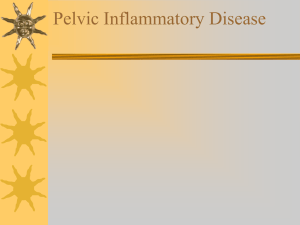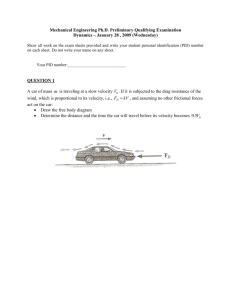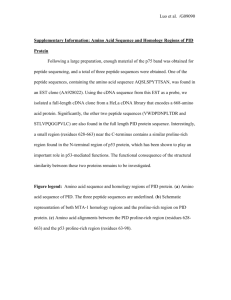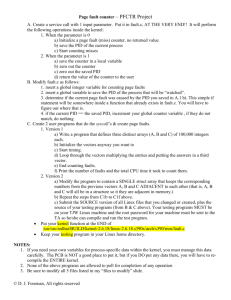Addressing gender issues in Participatory Innovation
advertisement
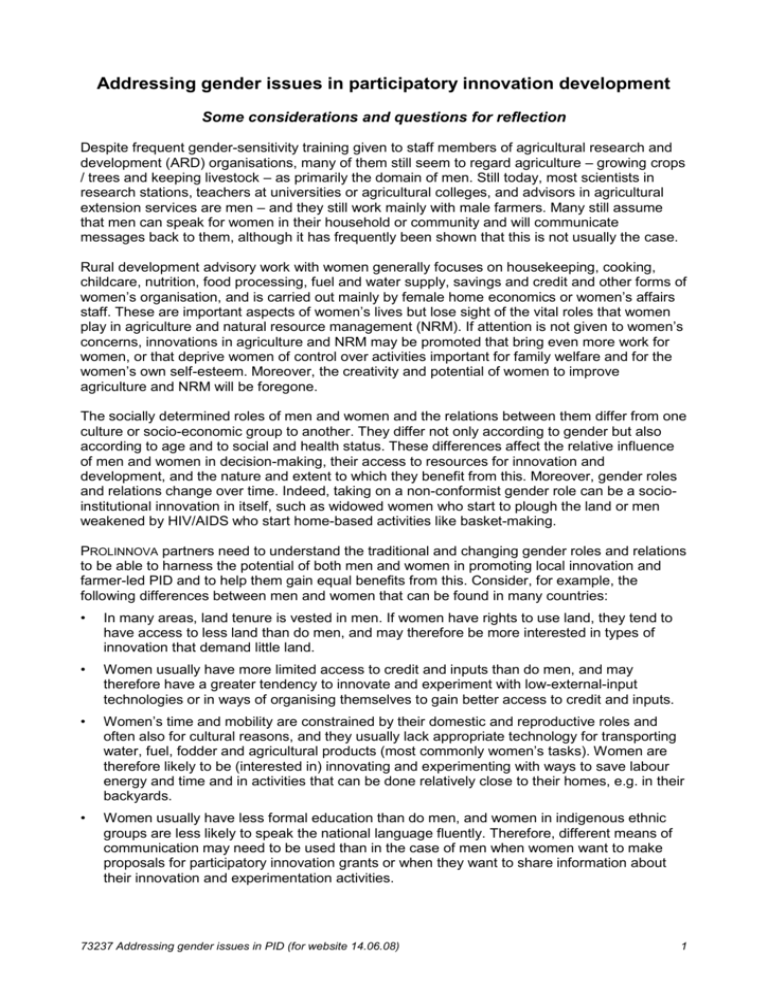
Addressing gender issues in participatory innovation development Some considerations and questions for reflection Despite frequent gender-sensitivity training given to staff members of agricultural research and development (ARD) organisations, many of them still seem to regard agriculture – growing crops / trees and keeping livestock – as primarily the domain of men. Still today, most scientists in research stations, teachers at universities or agricultural colleges, and advisors in agricultural extension services are men – and they still work mainly with male farmers. Many still assume that men can speak for women in their household or community and will communicate messages back to them, although it has frequently been shown that this is not usually the case. Rural development advisory work with women generally focuses on housekeeping, cooking, childcare, nutrition, food processing, fuel and water supply, savings and credit and other forms of women’s organisation, and is carried out mainly by female home economics or women’s affairs staff. These are important aspects of women’s lives but lose sight of the vital roles that women play in agriculture and natural resource management (NRM). If attention is not given to women’s concerns, innovations in agriculture and NRM may be promoted that bring even more work for women, or that deprive women of control over activities important for family welfare and for the women’s own self-esteem. Moreover, the creativity and potential of women to improve agriculture and NRM will be foregone. The socially determined roles of men and women and the relations between them differ from one culture or socio-economic group to another. They differ not only according to gender but also according to age and to social and health status. These differences affect the relative influence of men and women in decision-making, their access to resources for innovation and development, and the nature and extent to which they benefit from this. Moreover, gender roles and relations change over time. Indeed, taking on a non-conformist gender role can be a socioinstitutional innovation in itself, such as widowed women who start to plough the land or men weakened by HIV/AIDS who start home-based activities like basket-making. PROLINNOVA partners need to understand the traditional and changing gender roles and relations to be able to harness the potential of both men and women in promoting local innovation and farmer-led PID and to help them gain equal benefits from this. Consider, for example, the following differences between men and women that can be found in many countries: • In many areas, land tenure is vested in men. If women have rights to use land, they tend to have access to less land than do men, and may therefore be more interested in types of innovation that demand little land. • Women usually have more limited access to credit and inputs than do men, and may therefore have a greater tendency to innovate and experiment with low-external-input technologies or in ways of organising themselves to gain better access to credit and inputs. • Women’s time and mobility are constrained by their domestic and reproductive roles and often also for cultural reasons, and they usually lack appropriate technology for transporting water, fuel, fodder and agricultural products (most commonly women’s tasks). Women are therefore likely to be (interested in) innovating and experimenting with ways to save labour energy and time and in activities that can be done relatively close to their homes, e.g. in their backyards. • Women usually have less formal education than do men, and women in indigenous ethnic groups are less likely to speak the national language fluently. Therefore, different means of communication may need to be used than in the case of men when women want to make proposals for participatory innovation grants or when they want to share information about their innovation and experimentation activities. 73237 Addressing gender issues in PID (for website 14.06.08) 1 Finding out about gender issues in agriculture and NRM To be able to take a balanced approach in recognising and enhancing the capacities of both women and men in agricultural innovation, PROLINNOVA partners need to understand gender roles and responsibilities particularly in terms of: • division of labour • access to resources and benefits • decision-making (social and political influence) within the household and the community. There are various methods and tools of gender analysis that can be used to identify the roles, relations, needs and interests of men and women at different stages in their lives – as children, youths, adults and elderly people. For example, the following can be used to increase PROLINNOVA partners’ (including farmers’) awareness of gender issues in agriculture and NRM: • Rapid differentiated surveys of men’s and women’s (young and old) concerns in agriculture, e.g. using PRA (Participatory Rural Appraisal) tools such as: - Activity profile: exploring tasks and time inputs by gender and age, differentiating according to work related to reproductive roles (childcare, cooking, fetching fuel and water etc), productive roles (cropping, livestock-keeping, food processing, marketing etc) and community management roles (committee meetings, conflict resolution etc) - Daily timelines (who does what when over the day) - Matrix of access and control over resources (such as in Table 1) • Group interviews with farmwomen (without any inhibiting presence of husbands or other male authority figures in the village or group) to discuss their activities, problems and aspirations related to agriculture and NRM • Case studies of women’s, men’s, girls’ and boys’ activities in households selected according to sex of household head, family size, stage in family life cycle and access to resources (e.g. without livestock and/or with little land; with livestock and/or more land) • Community “portraits” to compare and contrast farming and NRM practices and gender division of labour, resources and responsibilities across villages or groups, to use as a basis for discussion within villages/groups about gender roles, how they differ, how they could be changed, and how this would affect family and community life. In such discussions, both men and women, young and old should be involved. Table 1: Access to and control* over resources for agriculture and NRM Resource Land Water Trees Labour: own family hired Livestock: large small Inputs: purchased produced in area Working implements Cash Credit Information Transport Who has access? Who has control? Implications for PID? * “Control” over a resource implies final decision-making over its use. Source: after HS Feldstein & SV Poats. 1989. Working together: gender analysis in agriculture. Kumarian, West Hartford. 73237 Addressing gender issues in PID (for website 14.06.08) 2 The women themselves should describe their activities and voice their views, just as men describe their own particular activities and voice their views. Men often cannot describe accurately the tasks they do not carry out themselves, such as making butter from milk. They may also underestimate their mothers’, wives’ and daughter’s contributions to work in crop and livestock husbandry and harvesting of natural resources. But even the women’s responses should be verified by direct observation, as women sometimes downplay their own agricultural activities, particularly if these do not conform to the community’s cultural norms (e.g. women behind the plough). Guidance on how to use these and other methods is provided in numerous books, e.g.: Feldstein HS & Jiggins J (eds). 1994. Tools for the field: methodologies for gender analysis in agriculture. Kumarian, West Hartford, CT. Feldstein HS & Poats SV. 1989. Working together: gender analysis in agriculture. Kumarian, West Hartford, CT. Pretty JN, Guijt I, Thompson J & Scoones I. 1995. Participatory Learning and Action: a trainer’s guide. International Institute for Environment and Development, London. Veldhuizen L van, Waters-Bayer A & de Zeeuw H. 1997. Developing technology with farmers: a trainer’s guide for participatory learning. ZED Books, London. Giving attention to gender issues in the field The following questions are meant to stimulate reflection on how you have dealt with gender issues thus far in your PROLINNOVA-related work, as well as to provide some ideas as to how you could give more attention to this. These questions should also help you in documenting your PROLINNOVA-related activities in a gender-differentiated way. Tables 1–3 provide matrixes which can serve as tools in the analysis. In identifying and documenting local innovation: • Did you deliberately seek local innovation in activities in which women play important roles or have priority concerns? (For example, in many areas, these may include keeping small ruminants and poultry, gardening, marketing agricultural products.) • When looking for local innovators, how did you ensure that both men and women innovators were included in your search? If you did not, why not? • Were both men and women involved in looking for local innovators? Did the relative number of men/ women innovators identified differ depending on whether men or women researchers / extensionists were looking for them? • Did the type of innovations developed by women in male-headed households differ from those of women in female-headed households? • Are your innovation catalogues/ databases well-balanced in featuring men and women innovators? Were gender and age among the criteria used in selecting innovators to include? • Which innovators were easier to identify – men or women – and why? • What socio-cultural aspects did you encounter that favoured or inhibited innovation by men or women? In designing and implementing experiments / research together with farmers: • Were roughly equal numbers of men and women involved in the discussions about the farmer-led PID: which innovations to explore, what questions to answer, how to design the research, what information to collect and how, etc? 73237 Addressing gender issues in PID (for website 14.06.08) 3 • Were male and female youths involved in planning and implementing the PID? If so, how? • Were female or male farmers more eager to be involved in joint experimentation? What caused these differences? How does this affect the process and outcome of the PID? • How did the male farmers’ and female farmers’ research questions and their criteria for assessing research results differ? (Women and men may have different aims and therefore different criteria for assessing innovations in crop / tree growing and livestock-keeping. Often, women seek reliability and stability of yield, availability of food in the hunger season, useable byproducts, and ease of harvesting, processing and storing. Were both women’s and men’s aims considered when formulating research questions and assessment criteria?) • Were the differences between innovations, interests and constraints of women in male versus female-headed households taken into account when considering innovations to explore further? (For example, female heads of household may have access to less land, equipment and livestock for ploughing.) • Before joint decisions about who in the farming community should carry out the experiments, did you clarify who is normally responsible for which tasks (including post-harvest activities such as threshing, winnowing, seed selection, storage, processing and marketing) and how rigid or flexible the division of labour is? Were the implications of this for the PID taken into account? (see Table 2) • More specifically, are the crop or livestock species included in the experiments normally the types that are cared for by women? If so, did women have relevant roles in the experiments? • Who drew up the criteria for selecting farmers to carry out the experiments? Who selected the farmers? Who were/are the experimenting farmers (gender, age, economic status)? • Did men or women in the community have better access to and more control over the resources needed for the local experimentation? What were the implications for community members with limited access or control? (see Table 2) • Did both men and women in the households / community identify what resources (including labour) they have and need for the PID and who will pay for the inputs? (see Table 3) • If crop trials were being planned, was it discussed and decided in the community whether women may continue harvesting “weeds” from the farmland for vegetables or fodder (if this is something they normally do)? • If changes in NRM were being tried out, was it discussed and decided in the community whether women and poor people may continue gathering natural products (if this is something they normally do)? • During the farmer-led joint experiments, who in the household/community gave the instructions and who did the actual work? • Who in the household / community collected which data from the experiments, and how was this related to the gender division of labour? • If your Country Programme (CP) is involved in the piloting of Local Innovation Support Funds (LISFs): how many men and women have benefited from grants made through the LISFs and what were the differences in size of grants to men / men’s groups versus size of grants to women / women’s groups? • How many men and women are in the LISF management committees at different levels? Table 2: Implications of different patterns of gender responsibility in farming for PID Patterns of gender responsibility Separate enterprises within the farm (e.g. men keep cattle, women goats; men grow cereals, women spices) Implications for PID Seek local innovations and support PID in both men’s and women’s enterprises 73237 Addressing gender issues in PID (for website 14.06.08) 4 Separate fields or grazing areas (e.g. men’s beans, women’s beans; men’s irrigated and women’s rainfed plots) Separate tasks (e.g. men plough, women sow, men weed, women spread manure) Shared tasks (e.g. both men and women are involved in harvesting) Women-managed farms Seek local innovations and support PID in both men’s and women’s fields / livestock-grazing areas Is the innovation to be explored likely to increase men’s or women’s tasks or require a change in their timing? Will the increase in labour correspond with the benefit to be gained by the person who exerts the labour? Does the innovation make this a separate task and, if so, what will this mean for relative influence of men and women within the household? Do these women develop different types of innovations than do male farmer managers? Do they have the resources and time to be involved in PID? If not, how can others in the community assist so that these women can be involved? Table 3: “Who” questions in planning PID Who … Questions for planning PID makes decisions? Is the innovation being explored oriented to only their goals and not the goals of others in the household/ community? Will the innovation increase or decrease their workload? Who pays for what? Will the PID require the use of these resources? Can other options be explored that require less of these resources? Will the uses made by different household / community members change as a result of the innovation? Who decides on sales? Who controls the money? Does this person also pay for the inputs? does the actual work? controls the land and capital resources? uses the products? controls the output? Participatory monitoring and evaluation (PM&E): During assessment of the PID results, the following questions could be considered, e.g. in both separate and mixed groups of men and women farmers, together with PID facilitators: • How were the products and byproducts coming out of the experiments used and by whom in the household / community? Who controlled the income from them? Were all these household / community members involved in doing the assessment? • How did men and women, younger and older, differ in their assessment of the PID process and results? • What impact did the innovation have on demand for and return to labour of different household / community members? Is this innovation resulting in a shift in gender roles? If so, what do the men and women think about it? • Have there been changes in the nature, amount and timing of availability of products (including byproducts and residues) as a result of the innovation, and what consequences do these changes have for which family / community members? • Are the inputs and services needed for scaling up the innovation normally available to both women and men? If not, what changes are needed to make equal availability possible? • Since starting the PID, has there been any difference in the extent to which women and men, younger and older, express themselves in public about ARD, both within the community and to “outsiders”, e.g. researchers, extension staff, NGO staff, policymakers at different levels? 73237 Addressing gender issues in PID (for website 14.06.08) 5 In farmers’ meetings and trips / cross-visits / farmer-to-farming sharing: • Who proposed the time to meet? local men? local women? women with young children? women without children? PROLINNOVA CP team members? If women were not involved in proposing the time, was the time of day/week/year convenient for them (not a time of labour peak for them?) • Were meetings scheduled to be short enough that women could still complete their daily chores in the household, livestock-keeping, etc? • Were the meeting held in locations that could be easily reached by both women and men and, if not, what arrangements were made so that both could attend? • Were arrangements made that participants had something to eat and drink during and after the meetings, so that women participants did not have to prepare this during the meeting? • Were arrangements made that small children were taken care of so that mothers could join the meeting or trip? Could women arrange this within their family / community? • Could the language used at the meetings be readily understood by both the women and the men? If translation into a local language was needed, how was this handled? • In what ways did the women and the men participate (mere presence, asking and/or answering questions, making comments and suggestions …)? • In mixed meetings, what proportion of participants was female, male, youth, adults? Did women and/or youth express themselves to a greater or lesser extent and raise different issues when they were in a higher proportion in the group? • In all-women or all-youth meetings, did women/youth raise different issues than when they were in mixed meetings? How did these issues differ? • What special efforts were made by PROLINNOVA partners to encourage women and/or youth to attend meetings (innovation fairs, PID planning, PM&E etc)? • What were the differences between men and women in sharing their innovations with others? How did these differences affect dissemination? Did the level of acceptance by other farmers, extensionists or researchers differ according to whether the innovations had been developed by men or women farmers? Giving attention to gender issues in institutions and multi-stakeholder partnerships Attention needs to be given to gender issues not only in the field but also within the institutions and multi-stakeholder partnerships concerned with ARD. You can analyse and document and – in the process – stimulate learning about gender issues in PID by discussing with people in ARD institutions some of the following questions: At national and/or sub-national level in multi-stakeholder platform building: • Was gender balance a criterion for selecting participants in multi-stakeholder meetings? • What was the actual gender balance in the meetings, and why was it so? • Does the multi-stakeholder platform examine its own gender balance periodically? If so, how often, what were the conclusions drawn and what actions did it take? • Is gender in PID a point on the agenda for discussion during platform meetings? If so, how often, what was discussed, and what actions were taken as a result of this discussion? • What difference did it make whether men or women were involved in the platform with respect to giving attention to gender issues in the CP, and in bringing in these issues also into their work in their respective organisations? 73237 Addressing gender issues in PID (for website 14.06.08) 6 • To what extent and how did you deliberately bring gender issues into your CP’s awarenessraising and policy-dialogue activities, e.g. in presentations to workshops, innovation catalogues, promotional materials, posters, selecting innovators to meet with policymakers? At institutional level in interactions within institutions involved in the CP (e.g. Ministry of Agriculture, agricultural university/college, research institution): • What difference did it make within the institution whether men or women were the key persons directly involved in the CP activities, e.g. with respect to taking PID seriously? • Has the institute become more aware of the need to give attention to gender issues in PID? How is this evident? • What have you done to highlight gender issues in PID within the institution? How successful has this been? • In the case of an educational institute, how have gender issues in PID been brought into the teaching materials and learning exercises? At sub-national level in PROLINNOVA training activities in your country • In selecting participants for in-country PID training, was a gender balance sought? Was it attained? If not, why not? What is being done about this? • In conducting the PID training, were gender issues incorporated and, if so, how? • What difference did it make whether PID trainees were men or women with respect to subsequent attention to gender issues in the work 1) on the ground with farmers, and 2) in the institutions involved, including their own? In your CP’s monitoring & evaluation activities: • Are you regularly doing gender-disaggregated recording of men’s and women’s involvement in PROLINNOVA-related activities in quantitative terms (e.g. number of male and female innovators, men and women involved in farmer-led joint experimentation/research and crossvisits, male and female participants in training sessions and workshops, men and women from institutions of ARD involved in the NSC and Working/Core Group, men and women in committees at different levels)? • Are you seeking reasons and remedies for any imbalances noted? • Are you disaggregating impacts of PID (not only of the innovations but also of the PID process) according to men and women, and including information about this in your documentation and presentations to policymakers? Quantitative recording of data can reveal the “what” but it does not reveal the “why”. To explain the results, answers to many of the qualitative questions listed further above will be needed. Members of your provincial or national multi-stakeholder learning platform can gain deeper insight by making field visits and facilitating focus-group discussions with specific groups, e.g. at field level: female household heads, male household heads, richer, poorer, younger, older community members; and within the partner institutions: male and female field staff and managers, both those involved and those not directly involved in the PID activities. It will be important to record their views and explanations, as qualitative data for M&E, to be able to explain the quantitative findings and, if necessary, to do something to change the situation. Ann Waters-Bayer, Chesha Wettasinha and Jitendra Sinha PROLINNOVA International Support Team 14 June 2008 73237 Addressing gender issues in PID (for website 14.06.08) 7




